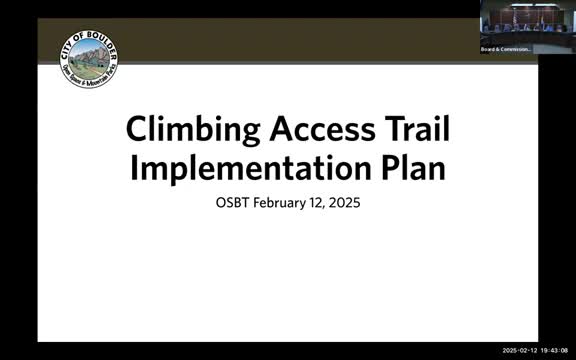OSMP proposes standardized signs, limited designations for climbing access trails after stakeholder review
February 15, 2025 | Boulder, Boulder County, Colorado
This article was created by AI summarizing key points discussed. AI makes mistakes, so for full details and context, please refer to the video of the full meeting. Please report any errors so we can fix them. Report an error »

City of Boulder Open Space and Mountain Parks staff on Feb. 12 presented the climbing access trail implementation process and recommended site‑specific outcomes for an initial set of climbing access routes following meetings with the Flatirons Climbing Council (FCC) and the Boulder Climbing Community (BCC).
Lede: Staff recommended designating roughly 2.4 miles of climbing access trail to provide sustainable approaches to bolted climbing formations, standardizing signs and using site‑by‑site monitoring before expanding the program.
Nut graf: The recommended approach responds to stakeholder requests for web maps, clearer wayfinding and reduced confusion around raptor closures while aiming to minimize additional resource impacts by keeping designation and sign infrastructure small and site‑appropriate. Staff proposed three sign types (blaze, wayfinding, hazard) and recommended designating the Maiden, Matron and the Slab and other specified formations; staff recommended not designating Devil's Advocate at this time but retaining and minimally managing the route.
What staff proposed: Recreation Stewardship Senior Program Manager Lisa Gonzalo told trustees the core team used trail management objectives (TMOs) adapted for climbing access and, after on‑the‑ground reviews with climbing stakeholders, proposed increasing the acceptable grade for a hiker‑class‑1 condition from up to 25% to up to 40% for climbing approaches; the change aligns design parameters with observed trail steepness on climbing routes. Staff also proposed small, uniform signs using climber symbology, a minimal color palette and smaller physical footprints so signs can be installed in rocky terrain.
Site‑by‑site results: Staff said counters installed Sept. 7, 2024 at four sites will remain through October 2025 to establish baselines. For the initial set, staff recommended designation for Maiden, Matron, Slab, Seal Rock, Skunk Canyon and Goose. Devil's Advocate, staff said, has very low human counts, is surrounded by several raptor closures and has ecological constraints; the recommendation was to retain the trail without designation and to install a single interior wayfinding sign and collaborate on a "leave no trace" message about gear left at boulders.
Stakeholder engagement: Staff credited lengthy discussions with FCC and BCC representatives and said climbers asked explicitly for online mapping of designated climbing access trails and for clear, minimal field signs to reduce confusion caused by varied existing signage in the system. Several public commenters, including Tom Isaacson and Peter Beal, praised staff outreach and said they supported the proposed approach.
Next steps: Staff will finalize the climbing access management plan, continue monitoring and begin implementation on sites not under camera monitoring. Staff said further work will fold 3.3 miles of previously designated climbing access trails into the new approach and will assess remaining miles of undesignated climbing access trails in future phases.
Lede: Staff recommended designating roughly 2.4 miles of climbing access trail to provide sustainable approaches to bolted climbing formations, standardizing signs and using site‑by‑site monitoring before expanding the program.
Nut graf: The recommended approach responds to stakeholder requests for web maps, clearer wayfinding and reduced confusion around raptor closures while aiming to minimize additional resource impacts by keeping designation and sign infrastructure small and site‑appropriate. Staff proposed three sign types (blaze, wayfinding, hazard) and recommended designating the Maiden, Matron and the Slab and other specified formations; staff recommended not designating Devil's Advocate at this time but retaining and minimally managing the route.
What staff proposed: Recreation Stewardship Senior Program Manager Lisa Gonzalo told trustees the core team used trail management objectives (TMOs) adapted for climbing access and, after on‑the‑ground reviews with climbing stakeholders, proposed increasing the acceptable grade for a hiker‑class‑1 condition from up to 25% to up to 40% for climbing approaches; the change aligns design parameters with observed trail steepness on climbing routes. Staff also proposed small, uniform signs using climber symbology, a minimal color palette and smaller physical footprints so signs can be installed in rocky terrain.
Site‑by‑site results: Staff said counters installed Sept. 7, 2024 at four sites will remain through October 2025 to establish baselines. For the initial set, staff recommended designation for Maiden, Matron, Slab, Seal Rock, Skunk Canyon and Goose. Devil's Advocate, staff said, has very low human counts, is surrounded by several raptor closures and has ecological constraints; the recommendation was to retain the trail without designation and to install a single interior wayfinding sign and collaborate on a "leave no trace" message about gear left at boulders.
Stakeholder engagement: Staff credited lengthy discussions with FCC and BCC representatives and said climbers asked explicitly for online mapping of designated climbing access trails and for clear, minimal field signs to reduce confusion caused by varied existing signage in the system. Several public commenters, including Tom Isaacson and Peter Beal, praised staff outreach and said they supported the proposed approach.
Next steps: Staff will finalize the climbing access management plan, continue monitoring and begin implementation on sites not under camera monitoring. Staff said further work will fold 3.3 miles of previously designated climbing access trails into the new approach and will assess remaining miles of undesignated climbing access trails in future phases.
View full meeting
This article is based on a recent meeting—watch the full video and explore the complete transcript for deeper insights into the discussion.
View full meeting
